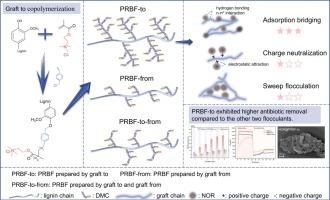浆料基絮凝剂的接枝聚合:链长依赖吸附桥接驱动高效抗生素去除
IF 11.3
1区 环境科学与生态学
Q1 ENGINEERING, ENVIRONMENTAL
引用次数: 0
摘要
合理设计可持续的絮凝剂以对抗水生系统中的抗生素污染需要对结构-活性关系的基本机制理解。在本研究中,通过不同的接枝共聚策略——“接枝到”和“接枝从”,合成了三种具有定制支链结构的纸浆废弃物基絮凝剂(PRBF-to, PRBF-from和PRBF-to-from)。综合结构表征证实了链长的显著差异,其中prbf -显示了最扩展的分支结构。在分离体系和腐植酸(HA)和高岭土存在的情况下,系统地评价了絮凝性能对四种代表性抗生素——诺氟沙星(NOR)、头孢氨苄(CFX)、土霉素(OTC)和磺胺甲恶唑(SMX)的去除效果。罐试验结果表明,PRBF-to的NOR去除率为26.15%±3.11%,比PRBF-from和PRBF-to-from分别高出16%和17%。机理研究强调了与链长相关的行为:根据XPS和相互作用力分析,prbf -主要通过电荷中和起作用,而prbf -通过其细长的结构利用扩展的氢键域和吸附桥接。相比之下,PRBF-to-from依赖于扫絮凝。吸附桥接在抗生素去除中的优势突出了链长度优化对增强絮凝剂-抗生素相互作用的关键重要性。本研究不仅为环保型絮凝剂的设计提供了木质素价值,而且还建立了一个链长度工程框架来定制污染物特异性去除机制。这些发现为抗生素负载环境中的废水处理提供了实用的策略。本文章由计算机程序翻译,如有差异,请以英文原文为准。

Harnessing graft-to polymerization for pulp reject-based flocculants: Chain-length dependent adsorption bridging drives efficient antibiotic removal
The rational design of sustainable flocculants for combating antibiotic pollution in aquatic systems requires a fundamental mechanistic understanding of structure-activity relationships. In this study, three pulp reject-based flocculants (PRBF-to, PRBF-from, and PRBF-to-from) with tailored branched-chain architectures were synthesized via distinct grafting copolymerization strategies – “graft to” and “graft from”. Comprehensive structural characterization confirmed significant differences in chain length, with PRBF-to demonstrating the most extended branched architecture. The flocculation performance was systematically evaluated for the removal of four representative antibiotics-norfloxacin (NOR), cefalexin (CFX), oxytetracycline (OTC), and sulfamethoxazole (SMX)- in both isolated systems and in the presence of humic acid (HA) and Kaolin. Jar test results demonstrated that PRBF-to achieved superior NOR removal efficiency (26.15 %±3.11 %), significantly outperforming PRBF-from and PRBF-to-from by 16 % and 17 %, respectively. Mechanistic studies highlighted chain-length-dependent behaviors: PRBF-from primarily functioned through charge neutralization, while PRBF-to leveraged extended hydrogen-bonding domains and adsorption bridging via its elongated architecture, as evidenced by XPS and interaction force analysis. In contrast, PRBF-to-from relied on sweep flocculation. The dominance of adsorption bridging in antibiotic removal highlights the critical importance of chain length optimization for enhancing flocculant-antibiotic interactions. This study not only advances lignin valorization for eco-friendly flocculant design but also establishes a chain-length engineering framework to tailor contaminant-specific removal mechanisms. These findings provide practical strategies for wastewater treatment in antibiotic-laden environments.
求助全文
通过发布文献求助,成功后即可免费获取论文全文。
去求助
来源期刊

Journal of Hazardous Materials
工程技术-工程:环境
CiteScore
25.40
自引率
5.90%
发文量
3059
审稿时长
58 days
期刊介绍:
The Journal of Hazardous Materials serves as a global platform for promoting cutting-edge research in the field of Environmental Science and Engineering. Our publication features a wide range of articles, including full-length research papers, review articles, and perspectives, with the aim of enhancing our understanding of the dangers and risks associated with various materials concerning public health and the environment. It is important to note that the term "environmental contaminants" refers specifically to substances that pose hazardous effects through contamination, while excluding those that do not have such impacts on the environment or human health. Moreover, we emphasize the distinction between wastes and hazardous materials in order to provide further clarity on the scope of the journal. We have a keen interest in exploring specific compounds and microbial agents that have adverse effects on the environment.
 求助内容:
求助内容: 应助结果提醒方式:
应助结果提醒方式:


